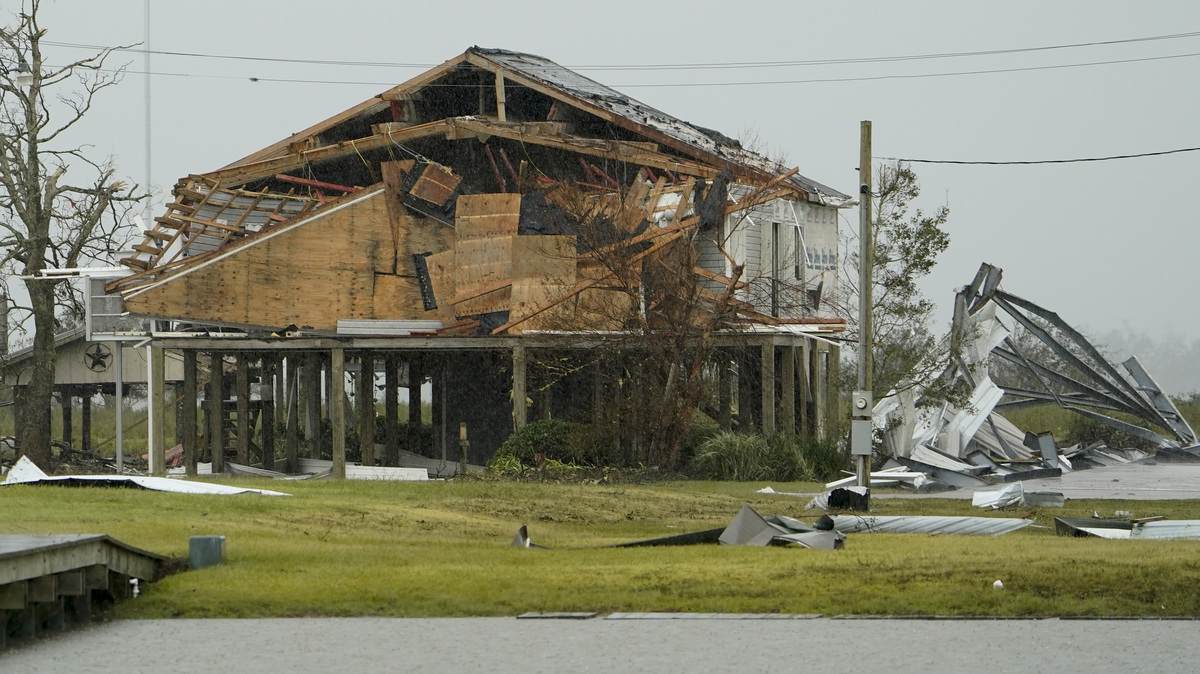Hurricane Laura Losses Include 10 Deaths, Up To $12 Billion. It Could’ve Been Worse

Enlarge this image
A home damaged by Hurricane Laura is seen in Hackberry, La., Friday. Damage estimates from the storm range from around $4 billion to $12 billion.
David J. Phillip/AP
hide caption
toggle caption
David J. Phillip/AP
A home damaged by Hurricane Laura is seen in Hackberry, La., Friday. Damage estimates from the storm range from around $4 billion to $12 billion.
David J. Phillip/AP
Hurricane Laura unleashed terrible winds on the Louisiana coast, but its effects are «looking relatively tame from an economic perspective» – especially when compared to other powerful storms, according to an early analysis by Moody’s Analytics.
Laura is blamed for at least 10 deaths, including five people who died from carbon monoxide poisoning — at least one case involves the use of a generator without proper ventilation. Four people died from trees falling on homes, Gov. John Bel Edwards said. And a man drowned after the boat he was on sank, member station WWNO reports.
The storm is estimated to have caused anywhere from $4 billion to $12 billion in damages to Louisiana and Texas. While Laura showed a staggering amount of power, its damage tally isn’t likely to come close to other strong storms such as Hurricane Katrina and Hurricane Harvey — the two costliest storms in U.S. history.
Katrina caused an estimated $160 billion worth of damage in 2005; Harvey caused $125 billion in damages in 2017.
A key reason for Laura’s smaller price tag is that while the hurricane came ashore with 150 mph winds — crashing large trees into houses, ripping roofs off buildings and tossing vehicles around – it avoided densely populated areas such as Houston and New Orleans.
Laura did not stall or hover, which can sharply increase rainfall totals in a given area. It also failed to send a catastrophic storm surge inland. If not for those factors, officials and analysts say, things could have been far worse.
«Nine to 12 feet of storm surge is still a lot of storm surge,» Louisiana Gov. John Bel Edwards said Thursday as state officials took stock of the damage.
Forecasters had warned of a surge up to 20 feet, but Laura’s center never tracked westward to pull water up the Calcasieu Ship Channel – a lucky break that the governor said «helped tremendously» in reducing the surge.
The lower range of the damage estimate come from Moody’s Analytics, where economist Adam Kamins notes that similar hurricanes «have carried a property damage-related price tag that is typically three to five times higher than that associated with lost output.»
Because the preliminary price tag of lost output is being estimated at $1.2 billion to $1.5 billion, Kamins’ overall damage estimate ranges from around $4 billion to $7 billion.
A slightly higher estimate comes from real estate tracking firm CoreLogic, which reports that insured losses for residential and commercial properties in Louisiana and Texas «are estimated to be between $8 billion and $12 billion.»
Storm surge-related losses make up only a small fraction of the total, the firm says.
When Laura hit Louisiana and Texas, it exposed more than 625,000 residential properties to tropical-storm-force conditions or worse, CoreLogic says. But it reports that only about 10,000 of those properties faced winds of a Category 3 storm or higher, thanks to Laura weakening as it moved inland.
Along the hard-hit parts of the coast, part of the economic fallout from the storm will only materialize over time.
Noting that natural disasters often cause a sudden spike in mortgage delinquencies, CoreLogic says that its analysis suggests «Hurricane Laura will add to the economic hardship families are already experiencing during the pandemic.»
Home mortgage delinquency rates were already notably above the national average on both sides of the Texas/Louisiana border, in the metropolitan areas of Beaumont, Texas, (9.3%) and Lake Charles, La., (9.5%), CoreLogic says.
- Hurricanes














Комментарии 0